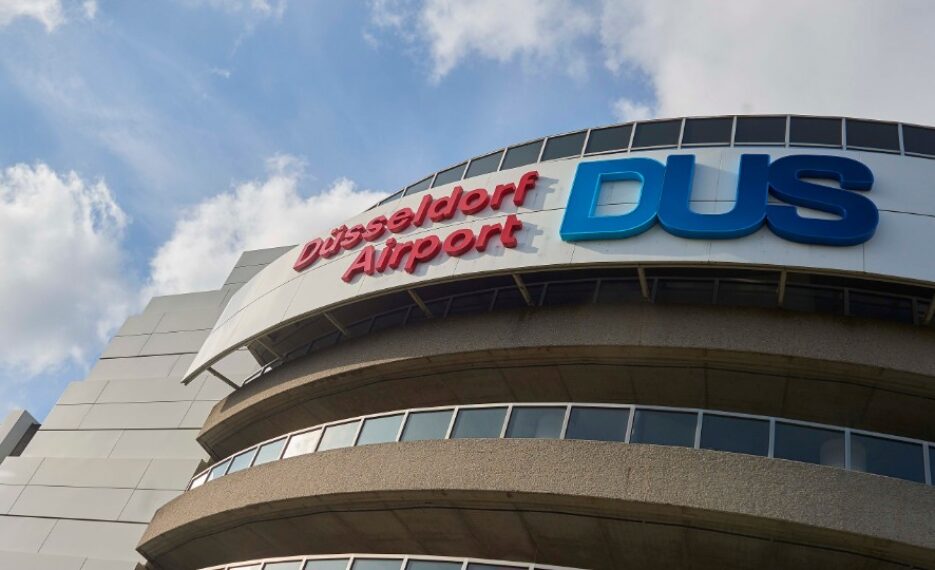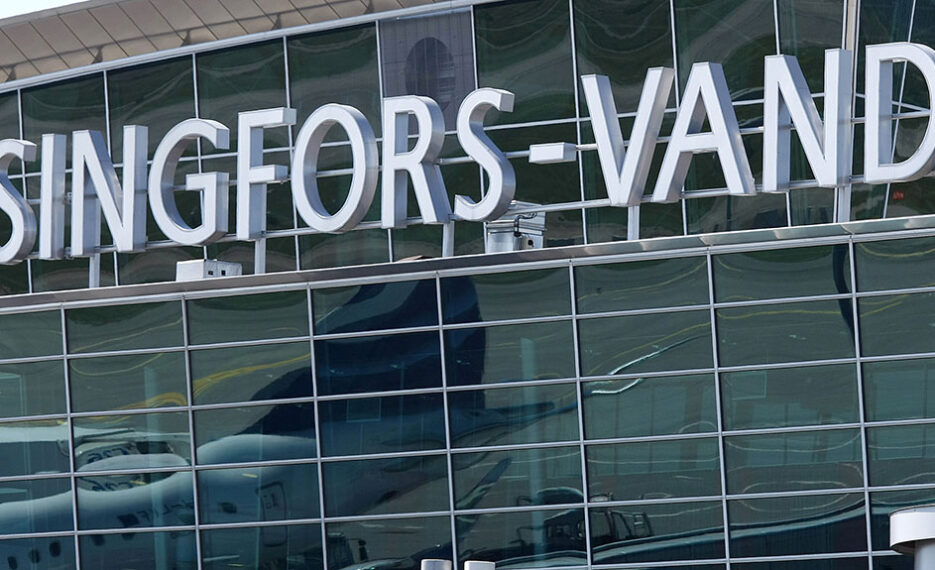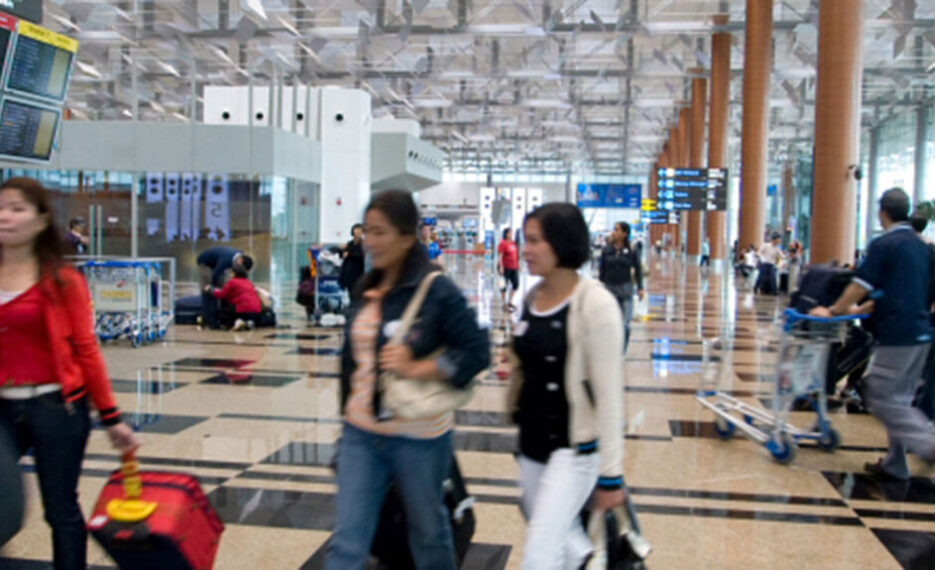Message on the COVID-19 situation from Dr. Christoph Beumer, Chairman and CEO. Continue reading
Baggage handling models that can help the implementation of IATA Resolution 753
IATA Resolution 753 on baggage tracking comes into effect in June 2018. The full details of Resolution 753 are available on the IATA website but, put simply, it says that 'IATA members shall maintain an accurate inventory of baggage by monitoring the acquisition and delivery of baggage'.

Table of contents:
- What does IATA Resolution 753 mean for airlines?
- What is the aim of IATA Resolution 753?
- What does IATA Resolution 753 mean for airports?
- How can IATA Resolution 753 be implemented and what are the minimum requirements?
- Where to install the equipment: challenges and possibilities
- Physical challenges in airport buildings
- Conclusion – Benefits of IATA Resolution 753
- Bag mishandling: long-term trends
What does IATA Resolution 753 mean for airlines?
This part of the IATA compliance, which would allow interoperability between airlines, is being looked after by the Passenger and Airport Data Interchange Standards (PADIS) Board. PADIS is governed by Passenger Services Conference Resolution 783 to develop and maintain Electronic Data Interchange and XML message standards for passenger travel and airport-related passenger service activities.
In addition to requiring airlines to demonstrate the delivery and acquisition of bags, it also specifies three key checkpoints where this should happen – aircraft loading, arrivals inject and transfers inject. Taking effect from June 2018, the Resolution is mandatory for all IATA airline members.
IATA members have committed themselves to:
demonstrate delivery of baggage when custody changes
demonstrate acquisition of baggage when custody changes
provide an inventory of baggage upon departure of a flight
be capable of exchanging these events with other airlines as needed

What is the aim of IATA Resolution 753?
The aim is to reduce the number of lost or delayed pieces of baggage by keeping track of it at every stage of its journey through the use of intelligent tracking capabilities. This will lead to a better customer experience and at the same time reduce the costs involved in tracing, retrieving and delivering missing or delayed bags. It will also reduce baggage fraud.
When a passenger checks in for a flight, a bag source message (BSM) is generated, which includes the date, flight number, destination, registration number and a unique barcode – this is typically referred to as an IATA Licence plate. The barcode on the tag is checked against a computer database of departing flights and set for delivery to the correct terminal and gate.
Following the security check, the baggage moves through the airport system on a series of conveyor belts or tray (tote) conveyors until it reaches the correct loading bay. Prior to being loaded onto the plane, the unique barcode is scanned or otherwise registered to make sure that the bag has reached the correct flight before being sent on its way.
Research has found that airlines which have a good system in place for keeping track of passengers’ baggage throughout this process have significantly less mishandling incidents than other airlines.
Courier companies have been tracking the whereabouts of parcels throughout their delivery journey for years and now, with the standardisation of systems in an airline’s existing technology infrastructure, airlines will be able to do the same thing with passengers’ baggage.

What does IATA Resolution 753 mean for airports?
By 2018, IATA member airlines will need to ensure that the airports they work with have the necessary IT systems and infrastructures in place to be able to support them in complying with Resolution 753. This means that all airports (existing or new) will need to assess their baggage handling infrastructures and fill in any gaps where necessary.
While baggage is handled by many different parties throughout the process – for example, airlines, the airport and baggage handling companies – one thing they all have in common is the Key Performance Indicator that they have committed to in order to provide the best possible service for their passengers.
IATA Resolution 753 will help enhance the registration of bag- gage and the collection of accurate information, which not only reduces mishandling, but also helps to speed up reconciliation and flight readiness for departing flights. The end result is information to help measure performance against service level parameters.
According to Resolution 753, airlines bear the ultimate responsibility for delivering the correct bag to the correct passenger, so they will have to ask airports and ground handlers to make various technological and system features available to them to meet the Resolution’s requirements. Although the airports, in theory, can turn compliance into a competition parameter, there is also an underlying business case for saving money.
Once Resolution 753 has taken effect, it will drive down the number of reports of lost baggage, especially the fairly high percentage of reports which are made while baggage is still being transferred to arrival reclaim while the passenger is reporting it as missing. Bags will be recorded at arrival reclaim, thus demonstrating that the bag really did arrive in the arrival baggage hall after being removed from the air- craft. The scanning and subsequently documented receipt of arriving baggage will play an important part in the airport driving down the cost of making baggage reports, not to mention the cost of running the lost bag procedure after the report has been filed. Furthermore the airport will have more cost transparency and know, with greater accuracy, who to charge for the cost of tracing and retrieving lost baggage if it does go missing.

How can IATA Resolution 753 be implemented and what are the minimum requirements?
As a minimum, the resolution requires some level of manual scanning, but automated solutions should also be considered. The main purpose is simply to make sure that the bag has reached its destination and is reconciled with its rightful owner at the right time.
Bags will need to be tracked by either automated readers or staff using mobile handheld devices. Other technology such as Global System for Mobile (GSM) communications/Global Positioning System (GPS)-enabled devices, Radio Frequency Identification (RFID) and beacons could also be used.
There are several options, which are already widely used at aircraft loading and transfer inject but rarely seen at the arrivals inject:
- Manual scanning – can be done without an automated baggage handling system, but requires extensive staff resources and handheld terminals. Every item of baggage must be handled manually and the process can be slow.
- Laser Scanning of Bag Tag – this is a widely used Automatic Tag Reading (ATR) technology found across most automated baggage handling systems, although it can not guarantee 100% readability. Because barcoded tags are so easily damaged during handling, their readability is almost always reduced by the time the bag arrives at a destination. Each time a bag is handled, the bag tag gets more distressed and wrinkled. The automated laser barcode scanners may not be able to read the bag tag number and it will then have to be diverted to a manual check, which takes additional time when connecting.
- The Automatic Tag Reading technology can be complemented or replaced by cameras. This type of Optical Character Recognition (OCR) technology and Video Coding System (VCS) are widely used in the parcel industry and OCR and VCS software can help to identify the flight numbers and airport codes. The integration of a VCS into the outbound Baggage Handling System (BHS) allows bag source information to be encoded while the bag remains in motion within the main BHS. This saves valuable time by ensuring that the baggage flow is not interrupted, in addition to freeing operations staff from manning a fixed Manual Encoding Station position. An optional Optical Character Reader (OCR) can also be integrated at server level as complementary technology to minimise the number of no-read tags. For Resolution 753, cameras can be installed on all arrival and transfer belts in the airport for non-readable barcodes to be processed remotely from a central VCS coding room. One video coded scanning system can resolve bag tag reading for an entire facility, potentially including multiple airlines.
- RFID – this includes RFID chips containing electronically stored information embedded in a tag and they offer very high readability, almost 100% with very few ‘no reads’. RFID is similar in concept to bar coding, but instead of a printed tag with static information that requires line of sight scanning, it contains a dynamic, application-specific integrated circuit (ASIC) which can be read at, and/or written to, every step along the chain. It does not require line of sight scanning and is therefore quicker. In addition, if airlines follow the IATA Recommended Practice 1740c, this will ensure the compatibility of the technology with airline data systems for RFID tags to be used in the interline baggage handling environment.
RFID tags are superior in this regard, but the main barrier to their use has always been cost – there is a higher cost per tag – but while airlines would have to pay for it, airports would also be the main beneficiary.
RFID tags have already proved successful on transfer baggage because the ‘read rate’ is higher. They are still readable even if crumpled or wet and the price for a tag can be justified by the reduction in baggage having to be routed for manual encoding, if it can’t be read automatically.
Resolution 753 may boost the use of hybrid paper bag tags with both an RFID antenna and a barcode; or an alternative would be the use of permanent RFID tags, which are either permanently embedded in the suitcase or permanently attached as a tag which the passenger always attaches to their bag when flying. As airports and airlines modernise their baggage processes, this is likely to be the next big thing in baggage handling advancements. Major international airports such as Hong Kong and McCarran (Las Vegas) have already carried out this type of upgrade and now utilise this type of technology.

Where to install the equipment: challenges and possibilities
By 2018, all airports will need to establish if they have the appropriate infrastructure in place to support the requirements of IATA Resolution 753. When considering how to demonstrate the delivery and arrival of bags at the three specified places – aircraft loading, arrivals inject and transfers inject – there are a number of scenarios to consider:
- Arrivals unload/inject – The main challenge here will be to find a solution that fits all airlines’ needs, especially if half the airlines serviced by the airport choose RFID while the other half settle for manual scanning. Two parallel systems will need to be set up to manage both sets of baggage.
- Transfers inject – Most airports are already supported by Automatic Target Reader solutions (ATR), Manual Encoding Station (MES) (for manual encoding if an automatic baggage tag reader cannot read the baggage barcode tag) and Baggage Reconciliation System (BRS) technology.
For efficient transfer of baggage, the future lies in sharing data to make it easier to anticipate possible risk and then target it for reduction or elimination. A transfer baggage monitoring software will enable baggage handlers and operators to detect potential problems, such as bags which are delayed, allowing positive action to be taken to ensure that the bag reaches the flight, or is available to be loaded onto the next available flight. The system displays detailed information about selected flights and transfer connections and shows flights with the most critical connection times at the top of a priority list.
- Aircraft loading – This is already supported by Automatic Tag Reader (ATR) technology and a Baggage Reconciliation System (BRS). Some airlines scan as late in the baggage handling process as directly in the hold (bulk baggage), which is the last change of custody for departing baggage.
Physical challenges in airport buildings

Another aspect of Resolution 753 is the physical challenge that lies in the infrastructure at airports where the conveyors or claim carousels might not be designed for attaching scanner arrays. Many older airports are not designed with these requirements in mind and so additional infrastructure will be needed to accommodate the new equipment.
Conclusion
The implementation of IATA Resolution 753 promises to bring benefits to everyone involved – airlines, airports and passengers – because accurate information about the whereabouts of baggage not only reduces mishandling complaints, but can also help to speed up reconciliation and flight readiness for departing flights and help measure performance against service level parameters.
Although IATA Resolution 753 is primarily the responsibility of the airlines, there will be no quick-fix solution for airports wanting to upgrade their systems. Co-operation between airlines, handlers and airports is essential to ensuring that every party involved shares the responsibility of making the new regulations work and equally benefits from their implementation.
Airlines will have to consider using more advanced technology such as cameras to help the airports read the information and airports may have to invest in more sophisticated scanner systems, as well as other necessary IT and controls upgrades.
This co-operation is also most likely to be fruitful in other areas. The enhanced tracking and tracing of bags should lead to more transparent processes where problem areas and bottlenecks can be identified. This will make it easier to pinpoint process areas in need of improvement.
Benefits of IATA Resolution 753
Increases the sharing of data across all interested parties (airlines, handlers, BHS owner/operator)
Enables proactive metrics
Reduces mishandling
Determines custody of every bag during different phases of the baggage handling process
Improves customer service
Reduces the possibility of baggage fraud
Improves baggage reconciliation
Reduces number of lost bag reports
Extended possibility to communicate bag status to passengers via airline/airport app
Bag mishandling: long-term trends
Global investment in new technology has seen the airline baggage mishandling rate reduced by 61.3% since 2007. As a result, airlines have been able to save a total of US$18 billion (according to the SITA 2015 Baggage Report).
After peaking at 18.88 bags per thousand passengers in 2007, mishandling of baggage in 2014 totalled 7.3 bags per thousand. In 2014, more than 80% of mishandled bags were delayed, due primarily to transfers between connecting flights. Mishandled transfer luggage comprised 49% of the 11.81 million delayed bags. (Source: SITA 2015 Baggage Report)
-
Baggage Handling
La flexibilité que les aéroports tirent d'une installation de Baggage Handling intelligemment conçue et à grande vitesse peut contribuer à améliorer leur efficacité en matière de traitement des bagages.Details
Our baggage handling systems in use

Do you have questions about IATA Resolution 753?
Do you have questions about IATA Resolution 753?
Your Contact Person
Johan Rajczyk
Global Sales Manager


